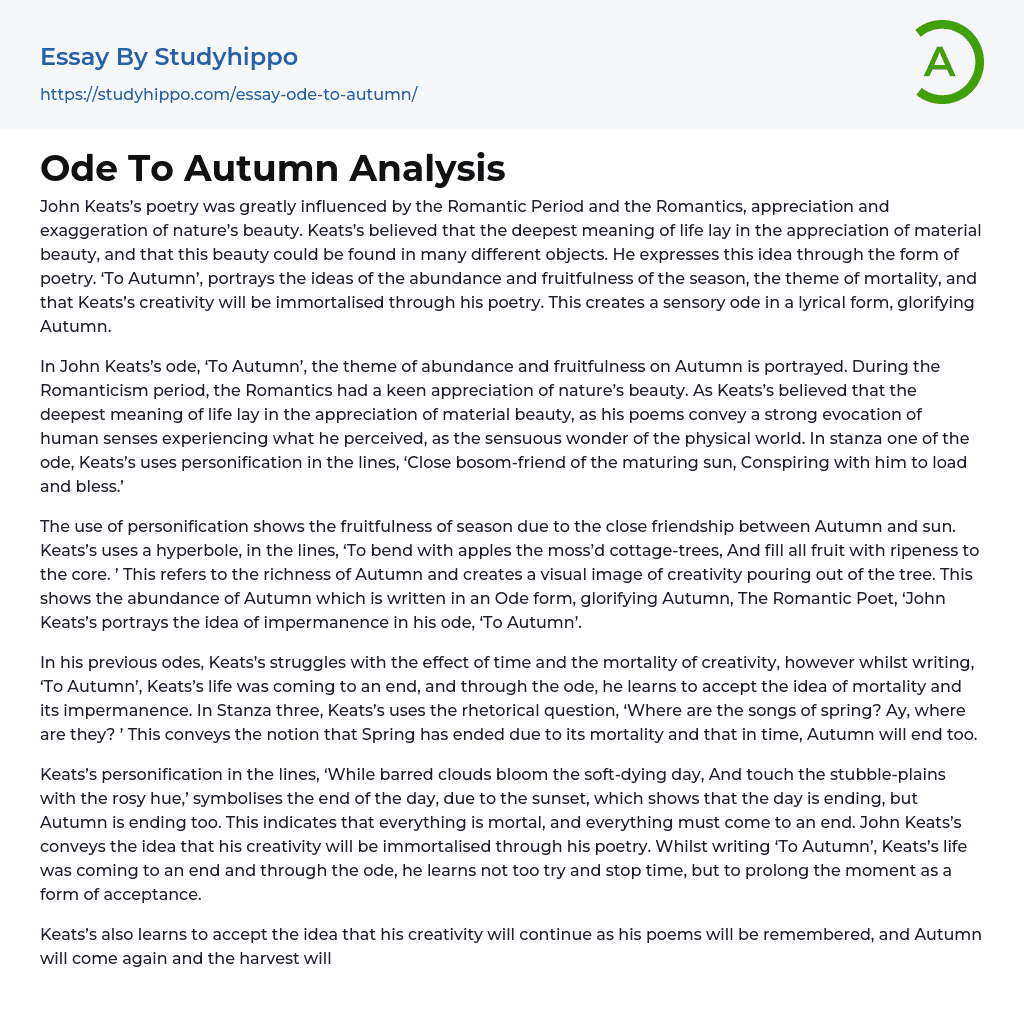John Keats’s poetry was greatly influenced by the Romantic Period and the Romantics, appreciation and exaggeration of nature’s beauty. Keats’s believed that the deepest meaning of life lay in the appreciation of material beauty, and that this beauty could be found in many different objects. He expresses this idea through the form of poetry. ‘To Autumn’, portrays the ideas of the abundance and fruitfulness of the season, the theme of mortality, and that Keats’s creativity will be immortalised through his poetry. This creates a sensory ode in a lyrical form, glorifying Autumn.
In John Keats’s ode, ‘To Autumn’, the theme of abundance and fruitfulness on Autumn is portrayed. During the Romanticism period, the Romantics had a keen appreciation of nature’s beauty. As Keats’s believed that the deepest mean
...ing of life lay in the appreciation of material beauty, as his poems convey a strong evocation of human senses experiencing what he perceived, as the sensuous wonder of the physical world. In stanza one of the ode, Keats’s uses personification in the lines, ‘Close bosom-friend of the maturing sun, Conspiring with him to load and bless.’
The use of personification shows the fruitfulness of season due to the close friendship between Autumn and sun. Keats’s uses a hyperbole, in the lines, ‘To bend with apples the moss’d cottage-trees, And fill all fruit with ripeness to the core. ’ This refers to the richness of Autumn and creates a visual image of creativity pouring out of the tree. This shows the abundance of Autumn which is written in an Ode form, glorifying Autumn, The Romantic Poet, ‘John Keats’s portrays the idea of impermanence i
his ode, ‘To Autumn’.
In his previous odes, Keats’s struggles with the effect of time and the mortality of creativity, however whilst writing, ‘To Autumn’, Keats’s life was coming to an end, and through the ode, he learns to accept the idea of mortality and its impermanence. In Stanza three, Keats’s uses the rhetorical question, ‘Where are the songs of spring? Ay, where are they? ’ This conveys the notion that Spring has ended due to its mortality and that in time, Autumn will end too.
Keats’s personification in the lines, ‘While barred clouds bloom the soft-dying day, And touch the stubble-plains with the rosy hue,’ symbolises the end of the day, due to the sunset, which shows that the day is ending, but Autumn is ending too. This indicates that everything is mortal, and everything must come to an end. John Keats’s conveys the idea that his creativity will be immortalised through his poetry. Whilst writing ‘To Autumn’, Keats’s life was coming to an end and through the ode, he learns not too try and stop time, but to prolong the moment as a form of acceptance.
Keats’s also learns to accept the idea that his creativity will continue as his poems will be remembered, and Autumn will come again and the harvest will continue. Keats’s uses the technique of alliteration in the lines, ‘And full grown lambs loud bleat from hilly bourn, Hedge-crickets sing; and now with treble soft. ’ The animal sounds used, represent the change of the season, from Autumn to Winter, and to furthermore the concept of moving on in life and how Autumn, will come again.
Keats’s uses onomatopoeia in the lines, ‘The red-breast whistles from a garden-croft; And gathering swallow twitter in the skies.’
The ‘Gathering swallow,’ represent the cycle of life, and how Autumn will come again and the moving on from events. This shows that Keats’s creativity, like the cycle of the season, shall never end and that his poems will be remembered. ‘To Autumn’ explores the ideas of the richness of Autumn, the impermanence and mortality of the season, and the idea that Keats’s creativity will be everlasting as his poems will be remembered. Together, this creates a sensual ode, written in a lyrical form with strong visual imagery that glorifies Autumn.
- Boo Radley essays
- Genesis essays
- Richard iii essays
- Alice in Wonderland essays
- On the road essays
- Ozymandias essays
- The Nightingale essays
- Holden Caulfield essays
- Animal Farm essays
- 1984 essays
- A Hanging essays
- Shooting An Elephant essays
- A Tale Of Two Cities essays
- Adventures Of Huckleberry Finn essays
- Arthur Conan Doyle essays
- Brave New World essays
- Characters In Hamlet essays
- Characters In Romeo And Juliet essays
- Desdemona essays
- Diary Of A Wimpy Kid essays
- First-Person Narrative essays
- Frankenstein essays
- Heart Of Darkness essays
- Jane Eyre essays
- Jay Gatsby essays
- King Duncan essays
- Librarian essays
- Little Red Riding Hood essays
- Lord Of The Flies essays
- Silas Marner essays
- The Cask Of Amontillado essays
- The Catcher In The Rye essays
- The Crucible essays
- The Handmaid's Tale essays
- The Reader essays
- Virgil essays
- Wuthering Heights essays
- Candide essays
- Castle essays
- J. D. Salinger essays
- Ulysses essays
- Ethan Frome essays
- In Cold Blood essays
- Outliers essays
- Tuesdays With Morrie essays
- The Art of War essays
- Wife of Bath essays
- Huckleberry Finn essays
- The Lady With The Dog essays
- Great Expectations essays




